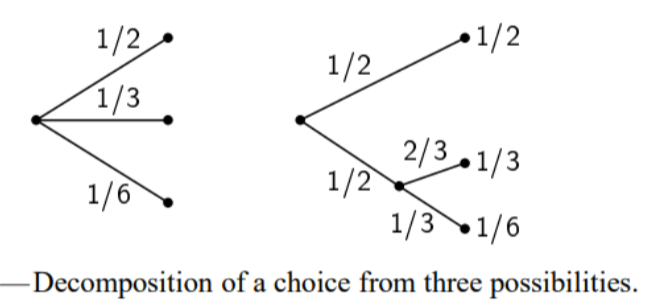Thermodynamic entropy
Formulas and definitions
- Thermodynamic parameters: measurable macroscopic quantities associated with the system (pressure, volume, temperature, etc).
- Thermodynamic state: is specified by a set of values of all the thermodynamic parameters necessary to describe the system.
- Thermodynamic equilibrium: condition when the thermodynamic state does not change in time.
- Equation of state: is a function of the thermodynamic parameters for a system in equilibrium and defines a surface
. - P-V diagram: projection of the surface of the equation of state onto the P-V plane
- Work:
- Heat:
where is the heat capacity.
I law of thermodynamics
Considering an arbitrary thermodynamic transformation with
which can be written in differential form as
II law of thermodynamics
The second law of thermodynamics can be expressed in two equivalent forms:
- Kelvin statement: There exists no thermodynamic transformation whose sole effect is to extract a quantity of heat from a given heat reservoir and to convert it entirely into work.
- Clausius statement: There exists no thermodynamic transformation whose sole effect is to extract a quantity of heat from a colder reservoir and to deliver it to a hotter reservoir.
Carnot engine
Entropy definition
The entropy between two states
We are usually interested in the difference in entropy of two states, which is defined as
where the path of integration is any reversible path joining
The
Shannon entropy
This part is heavily based on the Shannon's masterpiece " A mathematical theory of communication"
We can start the analysis of the concept of entropy in the Information field by studying a discrete information source that generates a message, symbol by symbol.
A physical system, or a mathematical model of a system which produces such a sequence of symbols governed by a set of probabilities, is known as a stochastic (random) process. Examples of these systems can be a natural language, a source of information, etc.
We can start introducing the concepts that will be useful later in a simple case where we have only five letters
which each have probability
We will also restrict our analysis to the case of independent choices (the probabilities of a letter is not influenced by the previous letters).
Forming a message with these rules leads to something similar to
We can slightly increase the complexity analysing a case where the probabilities (letter frequencies) are not the same. For example
A possible message in this case could be
To further complicate the structure of our system we can introduce the concept of transition probability
The following properties hold for the probabilities we just saw:
We could theoretically add probabilities for trigrams and so on.
The more constraints we add, the more we approach a real language (see the paper for more examples).
At this point we would like to find a way to measure “how much information is produced”. Such measure, let’s call it
- Should be continuous in the
- If all the
- If a choice is broken down into two successive choices, the original

Theorem (Definition of Shannon entropy)
The only
where
Demonstration
Example, binary entropy
See Nielsen Chuang, 11.2.1
In the simple case of two possibilities with probabilities
From the plot of
Properties
From the example above we already noticed some interesting properties of the quantity
- For a given
- Suppose there are two events,
while
It can be shown that
where the equality holds if the events are independent (
- Any change toward equalization of the probabilities
- If we have two events
Conditional entropy
We can also define the conditional entropy of
This quantity measures how uncertain we are of
Entropy measurement units
The choice of the logarithmic base corresponds to the choice of a measurement unit. The most common ones are the following:
Relative entropy
Given two probability distributions
even though the meaning of this quantity is not obvious, we can prove that it is a good measure of distance between two probability distributions because it is non negative and it is equal to zero if and only if the two probability distributions are identical (for a proof see Nielsen Chuang, Theorem 11.1)
